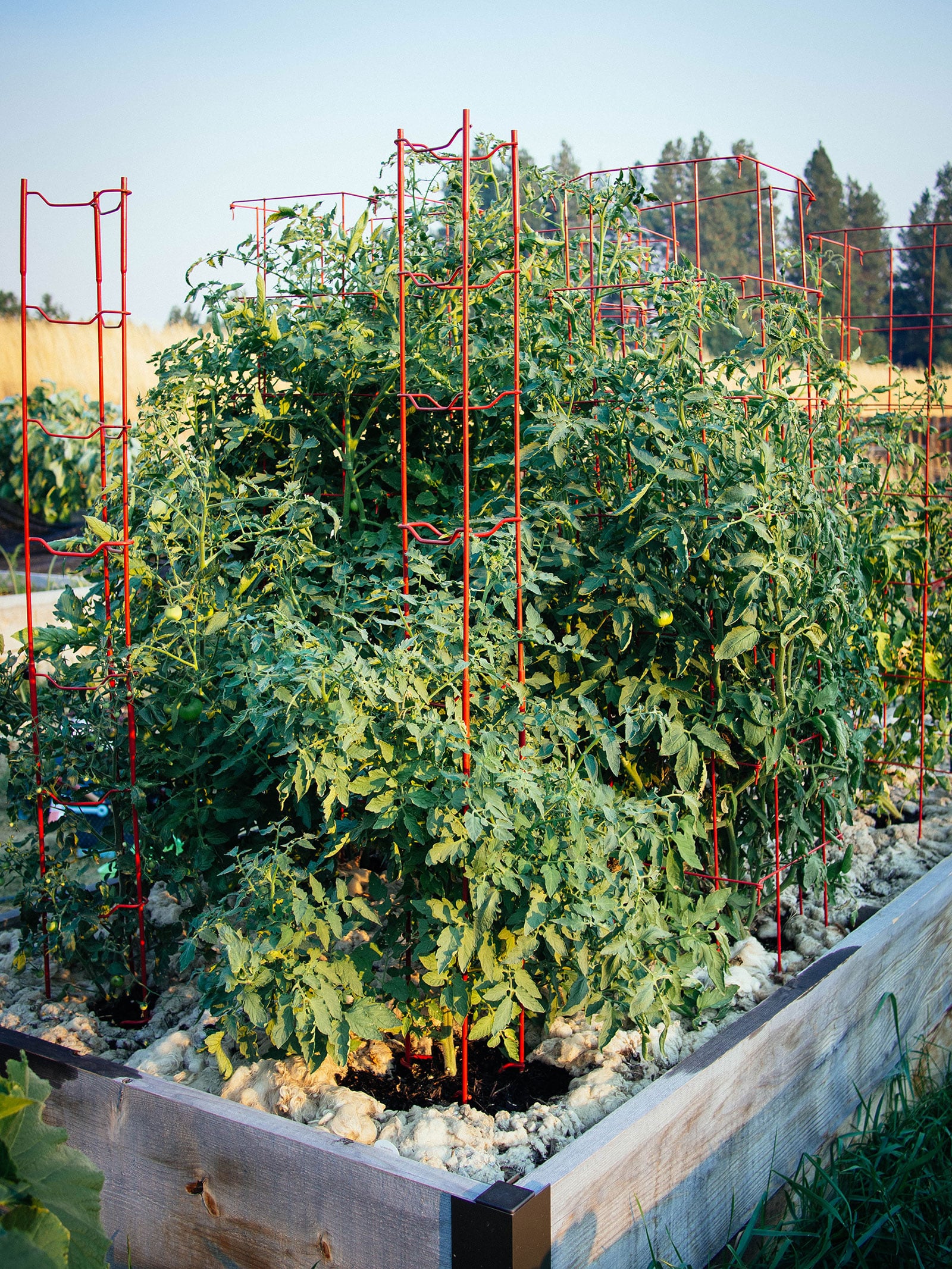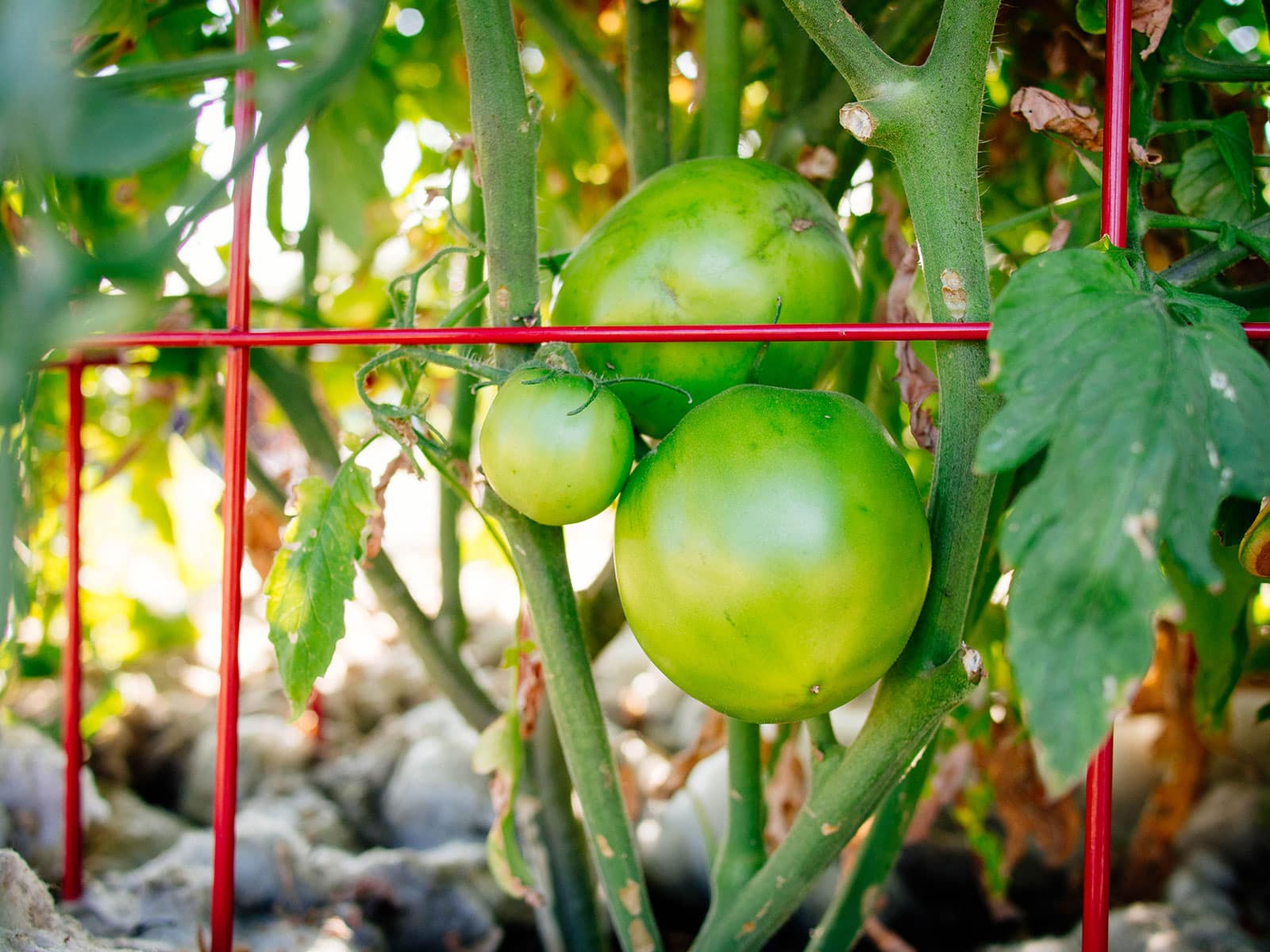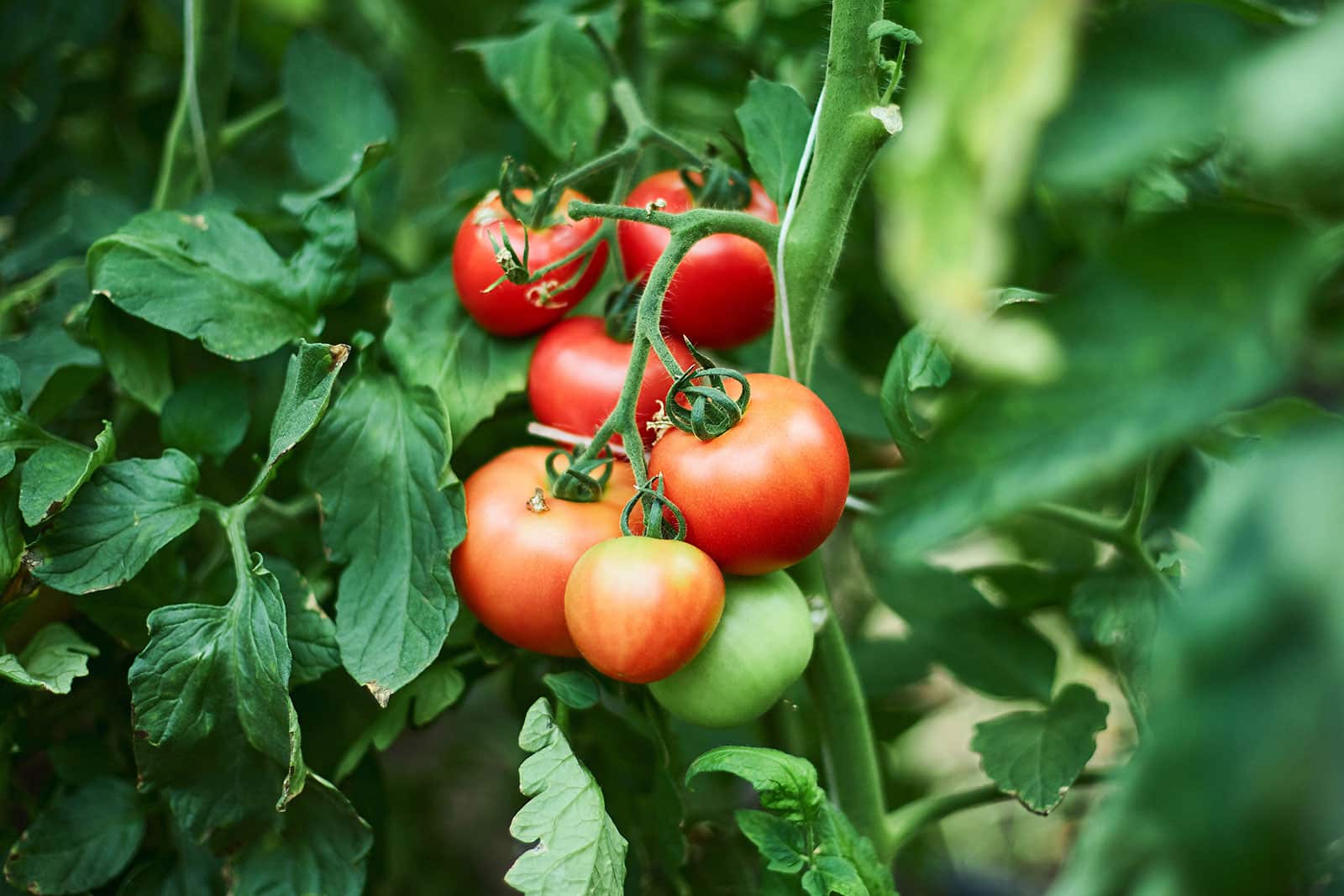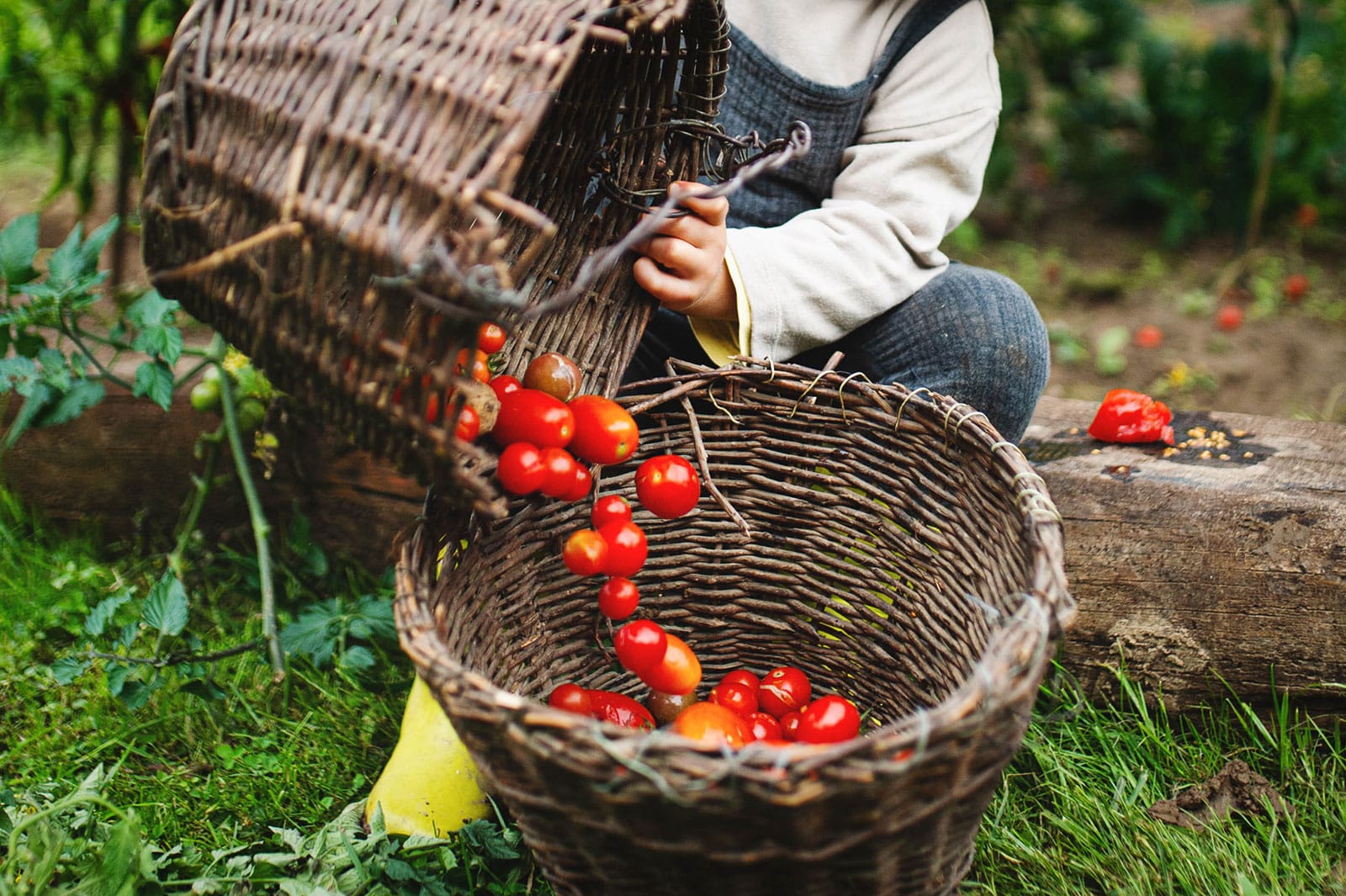Maybe you never got around to starting seeds early like you wanted to, or all your tomato seedlings succumbed to damping off or got eaten by mysterious critters. Maybe this spring has been a lot colder than it usually is or maybe—like me—you live in a region with a very short growing season.
Here in Central Oregon, I’m lucky to get 60 days of frost-free weather in a good year… but it’s usually more like 30, as it’s not uncommon to dip below freezing in July!
Read next: These are the best times to plant, based on your first and last frost dates
Without a heated greenhouse, I’ve given up on growing luscious, long-season tomatoes that need multiple months to ripen. But I also harvest around 25 pounds of vine-ripened tomatoes from each of my indeterminate plants every year, as I’m all about short-season tomatoes.
These fast-growing varieties produce big harvests before the first frost and don’t mind our chilly temps, and they’re perfect for people who don’t have three months of warm summer weather to wait around.
Another benefit: Tomatoes that ripen early are also less prone to catfacing, a deformity that occurs when the nights are cool and days are hot.
So if you’re procrastinating on starting seeds or thinking about skipping tomatoes this year because you’re tired of picking green, unripe tomatoes, there’s no need to suffer through another disappointing season.
Here are 83 short-season, cold-climate tomato varieties to try in your garden. You can purchase seeds to start now, or look for these varieties of starter plants at your local nursery or garden center.
(And to maximize your harvest, be sure to follow my best tomato-growing tips here!)
Disclosure: If you shop from my article or make a purchase through one of my links, I may receive commissions on some of the products I recommend.

What is the fastest-growing tomato?
That honor is a tie between Quedlinburger Frühe Liebe (an indeterminate type that matures in 40 days) and Sub-Arctic Plenty (sometimes marketed as Chilly Willie, a determinate type that matures in 42 days).
These are two of the world’s earliest tomatoes, and when you consider the fact that the best time to harvest tomatoes is actually when they’re still partially green, that means you can potentially harvest these varieties in just 30 to 35 days and bring them inside to finish ripening.
Quedlinburger Frühe Liebe
Originally developed for cool rainy nights, Quedlinburger Frühe Liebe (or as I like to say, QFL) is a German heirloom tomato variety that’s ready for harvest in just 40 days after transplanting (!!!) and keeps producing until killed by a freeze.
This makes it quite an amazing all-season plant and a real keeper in the garden if you’re prone to cold snaps.
QFL is sweet and flavorful with small, juicy red fruits that are perfect for salads or sneaking into your mouth as you do your garden chores.
The name means “early love of Quedlinburg”—Quedlinburg being a German town situated just north of the Hartz mountains.
Where to buy
Quedlinburger Frühe Liebe seeds
Sub-Arctic Plenty (Chilly Willie)
Although it’s often reported (erroneously) that this variety was developed in the 1940s by the US military to provide fresh tomatoes to Air Force troops in Greenland, Sub-Arctic Plenty was actually bred in Alberta, Canada, in the 1970s.
An heirloom tomato variety, Sub-Arctic Plenty has a unique ability to set fruit under cold conditions (not surprising, considering it needed to survive Canada’s prairie climates) and produces hundreds of small red fruit, about 1 to 2 inches wide, on a compact bush plant that needs no staking. It’s even been grown successfully in the southern Yukon, which borders Alaska!
But this tomato isn’t just for people in northern climates—it’s also great for gardeners in the South who want to get a crop in before the serious heat of summer sets in.
(In case you’re wondering why it isn’t good to have too much heat for tomatoes, temperatures that are consistently above 85°F can really stress plants. A heat wave may destroy pollen, cause blossom drop, and significantly slow down the ripening process.)
Related: How to water your plants and keep them healthy during a heat wave
In milder winter regions that don’t freeze, you can also start seeds for Quedlinburger Frühe Liebe or Sub-Arctic Plenty tomatoes in late fall and harvest in winter (as long as your plants get enough sun).
Where to buy
Sub-Arctic Plenty tomato seeds

What is the most cold-tolerant tomato?
Tomato plants, in general, can survive temperatures down to 32°F for short periods of time. But sustained temperatures below 50°F can cause slowed growth, severe damage to foliage and fruit, and ultimately, death.
What makes all the tomato varieties (listed below) cold-tolerant is not how much cold they can take at night, but how well they’re able to set fruit in cooler weather.
If you live in a place like San Francisco, whose summers are typically foggy and average 68°F during the day (but drop down to 50s at night), you need a tomato variety that will still bloom and ripen in chilly, wet and windy weather.
Some tomatoes, like those bred by Oregon State University, are parthenocarpic—they’re nearly seedless and don’t need to be pollinated to set fruit, so they can start producing earlier.
Of all the tomato types below, Coldset is a prolific producer with superior cold tolerance. It germinates in lower temperatures than normal, can be directly seeded into a cool garden, and will grow as long as the soil temperature is at least 65°F. Coldset is also said to be able to withstand very light frost.
Related: How soil temperature influences germination and root growth

The best short-season tomatoes for cool climates
Here’s a trick for choosing tomatoes that’ll do well in cool summers: Look in the names or descriptions for those that indicate Siberia, Russia, or other cold locations.
As you’ll notice in the list below, some of them are very appropriately named… I mean, Glacier? Oregon Spring? San Francisco Fog? Can you just feel the chill?!
In addition, Oregon State University’s vegetable breeding program has developed several tomato varieties that have become mainstays in many Pacific Northwest gardens.
For the past several decades, the OSU breeding program has focused on developing seedless tomatoes that do particularly well in the region’s cooler springs, and determinate tomatoes that bloom earlier and set fruit under cool conditions. (I’ve noted the OSU-developed varieties below.)
What you ultimately want is a short-season tomato that ripens in 70 days or less. Smaller varieties (like cherry or salad tomatoes) and determinate varieties (bushy plants that set all their fruits in a concentrated period of time) also have a better chance of ripening before frost.
Read more: Frost coming? These are the 4 fastest ways to ripen tomatoes in the garden
The most important thing to remember is that the time to ripen (also known as days to maturity or days to harvest) is expressed as number of days after transplanting outdoors. (This weird standard is explained more fully in my post about interpreting days to maturity for your particular climate.)
So even though Black Prince should ripen in 70 days (give or take a few), it could take up to 84 days or even longer, depending on day length and weather in your area. Your best bet is to err on the side of being “too early” if you’re trying to beat the clock on harvesting before frost.
Names denoted with an asterisk (*) are varieties I’ve personally grown and recommend.
If you’re looking to build up your short-season tomato collection, an excellent source for most of these seeds is TomatoFest.
Determinate tomato varieties
- Amber (60 days) – 2-ounce yellow-orange salad tomatoes, heirloom
- Aurora (59 days) – 4- to 6-ounce red slicing tomatoes, heirloom
- Beaverlodge (54 days) – 2- to 3-ounce red slicing tomatoes, heirloom
- Bison (70 days) – 2- to 3-ounce red slicing tomatoes, heirloom
- Bush Beefsteak (62 days) * – 8- to 10-ounce red slicing tomatoes, heirloom
- Coldset (65 days) – 3- to 4-ounce red slicing tomatoes, heirloom (can tolerate very light frost)
- Early Annie (60 days) – 4-ounce red slicing tomatoes, heirloom
- Early Boy (60 days) – 5-ounce red slicing tomatoes, hybrid
- Early Doll (59 days) – 4- to 5-ounce red slicing tomatoes, hybrid
- Early Wonder (54 days) – 6-ounce red slicing tomatoes, heirloom
- Floramerica (70 days) * – 7-ounce red tomatoes, hybrid
- Gold Dust (62 days) – 8-ounce yellow-orange slicing tomatoes, heirloom
- Gold Nugget (60 days, from OSU) * – 1-ounce yellow-orange cherry tomatoes, heirloom
- Grushovka (65 days) – 3-ounce dark pink plum tomatoes, heirloom
- Koralik (61 days) – 1-ounce red cherry tomatoes, heirloom
- Latah (55 days) – 2- to 3-ounce red slicing tomatoes, heirloom
- Legend (68 days, from OSU) * – 6- to 9-ounce slicing red tomatoes, heirloom
- Manitoba (58 days) – 6-ounce red slicing tomatoes, heirloom
- New Yorker (66 days) – 5-ounce red slicing tomatoes, heirloom
- Northern Delight (65 days) – 1- to 2-ounce red salad tomatoes, heirloom
- Northern Exposure (67 days) – 8-ounce red slicing tomatoes, hybrid
- Orange Pixie (52 days) – 4-ounce yellow-orange salad tomatoes, hybrid
- Oregon Spring (65 days, from OSU) * – 4- to 6-ounce red slicing tomatoes, heirloom
- Oroma (70 days, from OSU) – 4-ounce red plum tomatoes, heirloom
- Patio (70 days) – 3- to 4-ounce red slicing tomatoes, hybrid
- Polar Baby (60 days) * – 2-ounce red salad tomatoes, heirloom
- Polar Beauty (63 days) * – 4-ounce red slicing tomatoes, heirloom (said to have a Brandywine-like flavor)
- Polar Star (65 days) – 3- to 4-ounce red slicing tomatoes, heirloom
- Punta Banda (68 days) – 1-ounce red cherry tomatoes, heirloom
- Red Robin (54 days) – 1-ounce red cherry tomatoes, heirloom
- Red Siberian (65 days) – 3- to 5-ounce red slicing tomatoes, heirloom
- Santiam (60 days, from OSU) * – 3- to 5-ounce red slicing tomatoes, heirloom
- Sasha’s Altai (60 days) – 4- to 6-ounce red slicing tomatoes, heirloom
- Sandpoint (65 days) – 1- to 2-ounce red salad tomatoes, heirloom
- Scotia (60 days) – 4-ounce red slicing tomatoes, heirloom
- Shoshone (60 days) – 2- to 3-ounce red slicing tomatoes, heirloom
- Siberia (50 days) * – 3- to 5-ounce red slicing tomatoes, heirloom (note that this variety should not be confused with the similarly named “Siberian”)
- Silvery Fir Tree (55 days) – 4- to 10-ounce red slicing tomatoes, heirloom
- Sophie’s Choice (54 days) – 6- to 8-ounce red slicing tomatoes, heirloom
- Sub-Arctic Plenty (42 days) – 2-ounce red tomatoes, heirloom
- Sugar Baby (54 days) * – 1- to 2-ounce red salad tomatoes, heirloom
- Taxi (68 days) – 4- to 6-ounce yellow slicing tomatoes, heirloom
- Tiny Tim (50 days) – 1-ounce red cherry tomatoes, heirloom (this is a true dwarf tomato plant, and a great option for a tomato you can grow indoors year-round)
- Washington Cherry (60 days) – 1-ounce red cherry tomatoes, heirloom
- Zhezha (69 days) – 10-ounce red slicing tomatoes, heirloom
Semi-determinate tomato varieties
- Alaskan Fancy (54 days) – 1- to 2-ounce red salad tomatoes, heirloom
- Beliy Naliv (54 days) – 3- to 6-ounce red slicing tomatoes, heirloom
- Celebrity (70 days) * – 8-ounce red slicing tomatoes, hybrid
- Glacier (55 days) * – 2- to 3-ounce red slicing tomatoes, heirloom
- Nikolayev (70 days) – 1-ounce yellow cherry tomatoes, heirloom
- Prairie Fire (65 days) * – 2-ounce red- and orange-striped grape tomatoes, hybrid (super sweet, rated 10 out of 10 on the Brix scale and a huge hit with kids)
- Siletz (70 days, from OSU) * – 10- to 12-ounce red slicing tomatoes, heirloom
Indeterminate tomato varieties
- Alicante (70 days) * – 2- to 6-ounce red slicing tomatoes, heirloom
- Anna Russian (70 days) * – 14- to 16-ounce red slicing tomatoes, heirloom
- Azoychka (70 days) – 10- to 16-ounce yellow slicing tomatoes, heirloom
- Black Cherry (64 days) * – 1-ounce dark purple cherry tomatoes, heirloom (one of my longtime favorites and also one of the first tomato varieties I ever grew)
- Black Prince (70 days) * – 3- to 5-ounce purple-red slicing tomatoes, heirloom (I usually grow this every year because it has great flavor and does very well in my Central Oregon climate)
- Bloody Butcher (54 days) – 4-ounce red slicing tomatoes, heirloom
- Earliana (68 days) – 6-ounce pink slicing tomatoes, heirloom
- Early Girl (52 days) * – 6- to 8-ounce red slicing tomatoes, hybrid
- Early Yellow Stripe (69 days) – 2- to 4-ounce red- and yellow-striped tomatoes, heirloom
- Fireworks (60 days) – 8- to 10-ounce red slicing tomatoes, heirloom
- Gregori’s Altai (67 days) – 8- to 12-ounce dark pink slicing tomatoes, heirloom
- Helsing Junction (69 days) – 1-ounce purple-black cherry tomatoes, heirloom
- Husky Gold (70 days) – 5- to 7-ounce yellow-orange slicing tomatoes, hybrid
- Jetsetter (64 days) – 8-ounce red slicing tomatoes, hybrid
- June Pink (68 days) – 8- to 16-ounce pinkish-red slicing tomatoes, heirloom (sometimes marketed as “Pink Earliana”)
- Kimberley (69 days) * – 1- to 2-ounce red salad tomatoes, heirloom (incorrectly marketed as “Kimberly” by some sellers, this is one of my favorite early-season cherry-type tomatoes)
- Mrs. Maxwell’s Big Italian (69 days) – 1- to 2-pound pink slicing tomatoes, heirloom
- Moskvitch (60 days) – 4- to 6-ounce red slicing tomatoes, heirloom
- Northern Lights (55 days) – 8- to 16-ounce yellow and orange bicolored tomatoes, heirloom
- Nova (60 days) – 1-ounce orange or red grape tomatoes, hybrid
- Orange Roma (69 days) – 2- to 3-ounce yellow-orange plum tomatoes, heirloom
- Peche Jaune (67 days) – 1- to 2-ounce yellow-orange salad tomatoes, heirloom
- Purple Bumble Bee (68 days) – 1-ounce red- and green-striped cherry tomatoes, heirloom
- Quedlinburger Frühe Liebe (40 days) – 2-ounce red salad tomatoes, heirloom
- San Francisco Fog (70 days) * – 1- to 2-ounce red salad tomatoes, heirloom
- Severnye (70 days) – 8- to 12-ounce pink slicing tomatoes, heirloom
- Slava (65 days) – 1- to 2-ounce red salad tomatoes, heirloom
- Stupice (55 days) * – 3- to 6-ounce red slicing tomatoes, heirloom
- Tommy Toe (70 days) – 1-ounce red cherry tomatoes, heirloom
- Yellow Marble (65 days) – 1-ounce yellow cherry tomatoes, heirloom
- Yellow River (70 days) – 2- to 3-ounce yellow-orange salad tomatoes, heirloom
- Zarnitza (60 days) – 6- to 8-ounce red slicing tomatoes, heirloom
More tomato growing posts to explore:
- Grow Tomatoes Like a Boss With These 10 Easy Tips
- How to Grow Tomatoes in Pots—Even Without a Garden
- How to Best Fertilize Tomatoes for the Ultimate Bumper Crop
- How to Repot Tomato Seedlings for Bigger and Better Plants
- Why and How to Transplant Tomatoes (a Second Time)
- Planting Tomatoes Sideways: How Growing in a Trench Results In Bigger Healthier Plants
- Florida Weave: A Better Way to Trellis Tomatoes
- Conquer Blossom End Rot and Save the Harvest
- Can You Eat Tomato Leaves? The Answer Will Surprise You
- Why Tomato Leaves Have That Unique Smell
- The Power of Fermenting and Saving Tomato Seeds
- 4 Fastest Ways to Ripen Tomatoes in the Garden and Beat the First Frost
- The 30 Best Tasting Heirloom Tomato Varieties (By Color!)
- 83 Fast-Growing Short-Season Tomato Varieties for Cold Climates
- The Best Time to Pick Tomatoes for Peak Quality (It’s Not What You Think!)
















Thanks for sharing this really useful information. ‘Celebrity’ has a new version called ‘Celebrity Plus’ which I grew last year. I grew ‘Celebrity’ for years in north central Florida because its disease resistance and adaptability. The Florida organic tomato growing season is actually shorter than in New England where I’m from and where I returned (Vermont) in 2020. ‘Celebrity’ outproduced all the other varieties that I tried in Florida, and one ‘Celebrity Plus’ plant probably outproduced all of my daughter’s plants combined. (She is an accomplished gardener. That wasn’t the variable.) In FL I mostly grew tomatoes in 25 gal. or 35 gal. containers, usually with either Malabar spinach or cornfield-type pole beans coming up through the toms, twining to hold them to cage and poles. I also planted the perimeter with small plants such as celery or, for faster yields, pac choi. I made juice from ‘Celebrity Plus’ last year, and it was far and away the best tasting tomato juice I’ve had in my 85 years.
Any suggestions for tomato varieties to grow in hell? Or, rather, the low desert of Arizona?
Love Garden Betty. Thanks for your wonderful site and information. J
Thank you! What a great list.
PS: I’m in Portland, and so far my favorites have been Juliet and Cherry Roma. Both produced beautifully in my tiny urban garden.